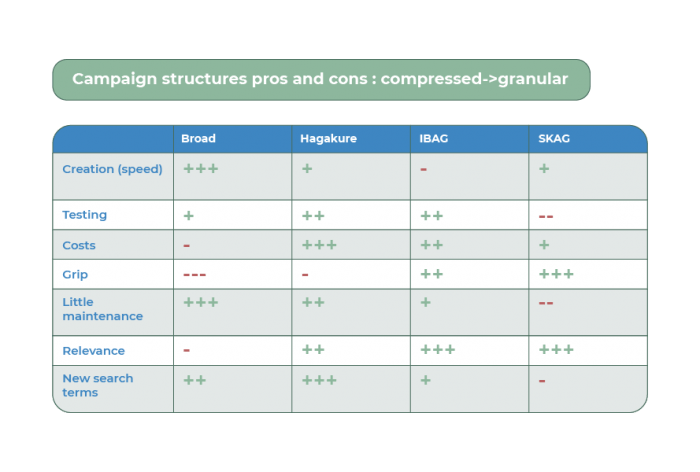4 best practices in (re)structuring campaigns
In principle, you structure once, when creating your campaigns, but it is possible that you will restructure the campaigns because you have changed your strategy. Whatever situation you are in, there are always four best practices to follow:
- Branded: Keywords related to your own brand (branded) should be in a separate campaign; separate from the other keywords (non-branded). Branded keywords have a different role within the conversion funnel.
- Goal (KPI): Keywords with a different goal belong in a different campaign. It is more difficult to read the performance if keywords with different goals are in different campaigns. It is also more difficult to set the right goals with smart bidding.
- Budget: Budgets can only be set at campaign level. Keywords with a different budget, therefore, logically belong in a different campaign.
- Naming convention: A good campaign structure needs an unambiguous campaign name; also known as the Naming Convention. You can read more about this in this blog entry about naming convention.
4 common Google Ads Campaign structures
There is actually no dispute about the above best practices. However, which follow-up structure is chosen often depends on various considerations that specialists (have to) make. Google Ads campaign structures can be very compressed or very granular.
In general, three Campaign structures can be recognized:
- Broad structure
- Hagakure structure
- IBAG structure
- SKAG structure
Tip: read about the best Performance Max campaign structure.
Broad, Hagakure, IBAG and SKAG, all known to a greater or lesser extent and from simple to complex – i.e., from compressed to granular.
In the table below, you can see at a glance the advantages and disadvantages of the different structures. Below, I explain the advantages and disadvantages of each of the different Google Ads Campaign structures:

Broad campaign structure in Google Ads
Popular with starters and small advertisers
As a new advertiser, you can easily get to know Google Ads through this campaign type. This campaign structure is therefore popular with small SMBs just starting out with Google Ads. In fact, Google’s new smart campaigns and previous AdWords Express campaigns also have a broad campaign structure.
One campaign is central to the broad campaign structure. It contains various ad groups that in total focus on a broad site theme. Each ad group has a large number of keywords (usually 15 to 20).
The keywords use a broad matching to be triggered by as many searches as possible. Typically, this method is combined with one of Google’s automatic bidding strategies to give the algorithms as much freedom as possible.
Advantages of Broad structure:
The simplicity of this structure brings some advantages, especially for the small advertiser:
- Quick to create: Due to the limited amount of campaigns and ad groups, this structure is easy to create.
- Low maintenance: This Google Ads campaign structure requires little maintenance. This can be of decisive importance for small budgets, because otherwise the management costs may be too large a propotion of the overall cost.
- New keywords: Because the keywords use broad matching, there is a much lesser need to search for new keywords yourself. This allows you to generate more traffic, without having to do extensive keyword research yourself.
Disadvantages of broad structure:
However, if the campaign budgets are or become larger, the disadvantages of this structure will outweigh the advantages. The main drawbacks are:
- Learning money: Because your keywords are set broadly, you can get a lot of traffic that is not relevant enough. You can exclude this traffic afterwards, but the costs have already been incurred because you have to pay for every click. As a result, the conversion rates are lower and therefore the costs per conversion are higher.
- Lower relevance: A limited number of ad groups means that ad texts and landing pages are less likely to match the user’s search intent. This can result in low-quality scores and, therefore, lower positions in Google, at a higher cost.
IBAG campaign structure in Google Ads
Based on the user’s search intent
IBAG stands for intention-based ad groups. It is in between the SKAG structure and the broad structure.
The IBAG structure is, just like the TBAGS (theme-based ad groups) / STAGS (single theme ad groups), a theme-based structure where the search intention, the goal of the user when entering in Google, is the theme.
Within a theme-based classification, this is the most logical campaign structure, as it takes into account the highest possible relevance. Is another ad text or landing page more relevant? Then that keyword would belong in a different ad group.
Take the following keywords for example: white sneaker, white sports shoe, and black sneaker. In the IBAG structure, the first two keywords are in the same ad group. Sneaker and sports shoe are synonyms of each other.
However, the last keyword will be placed in a separate ad group because the search intent is clearly different. In the latter case, the user is looking for a black sneaker and therefore wants to see an advertisement and landing page with a black sneaker.
Finally, it is common practice within the IBAG structure to put the same keyword, but with different match types, in the same ad group. The search intention between the types does not deviate.
Take, for example, the search terms: “white sneakers” and “buy white sneakers”. In principle, exact match only activates the first search term, while broad match modified activates both search terms. However, the search intent is the same, so there is no point in splitting the match types.

Advantages of the IBAG structure
The IBAG campaign structure is located in the so-called “Goldilocks zone”; not too granular and not too compressed. This gives it the advantages of the broad and SKAG structure, but without the main drawbacks:
- Smart bidding strategies: Due to its more compact design than the SKAG structure, this structure works better with Google’s smart bidding strategies. With a more compact design, Google has more data to include the full context behind the click to determine the correct bid. The need to split up campaigns further becomes a lot smaller, as the smart bidding strategies already take into account all the factors that increase the chance of a conversion.
- Relevance: because the ad groups are classified based on search intent, you automatically achieve the highest possible relevance. This ensures a high-quality score, more impressions, high rankings and lower CPCs.
- Ad Text Testing: Testing the best ad text is easier than with the SKAG structure, as the data is less fragmented. In addition, the testing of the texts is more accurate than in the Broad structure, because the texts better match the search intent of the user.
- No major drawbacks: the maintenance is a lot easier than with the SKAG method, since you no longer have to exclude keywords crosswise. As a result, you do not exclude unnecessary certain traffic. You are also much less likely to reach the account limits. Finally, you have more conversion data at the account level. This gives you more options for applying smart bidding strategies.
Disadvantages of the IBAG structure
The disadvantages of the IBAG structure are generally fewer than those of the broad and SKAG structure. Yet IBAGs also have some drawbacks, which may be an issue for some advertisers. As a result, this may not be the best method for them:
- Grip: The main disadvantage of the IBAG method is that you lose more grip than with the SKAG method. For some advertisers, this grip is very important, because otherwise the campaigns are more difficult to oversee. Sometimes, the search intention between different keywords is vastly different. A small deviation from the meaning can make the keyword immediately no longer relevant.
- Creation: The IBAG structure can also be more difficult to create than the broad and SKAG structure. This is because IBAGs have more different ad texts and landing pages than the broad structure and it takes more time to group keywords with the same search intent.
SKAG campaign structure in Google Ads
Each keyword has its own ad group
In the very granular SKAG structure, each keyword has its own ad group. SKAG is also known as Single Keyword Adgroups. It is customary within this setup to create ad groups twice. One ad group for exact match and one for broad match modified (BMM); a method also called match type mirroring.
The SKAG structure is usually combined with an alpha / beta method. New exact match ad groups are created for new search terms from the BMM ad groups when there are sufficient impressions or clicks.
The search term is then excluded from the ad group it originated from. Some advertisers split the campaigns even further, for example based on type of device, location or type of target group (for example, returning versus existing visitors).
Advantages of the SKAG method
The SKAG method was one of the most popular campaign structures for specialists. I say ‘was’ because the benefits are slowly disappearing, thanks to smart bidding improvements and the new feature of “exact match keywords”.
Due to its complexity, this method is less popular with first-time advertisers. This method has three main advantages:
- High relevance: The biggest advantage of this method is that you can easily match the ad text and landing page exactly to the specified keyword. You do this by placing the keyword in the header, path and description. This ensures a high relevance and therefore a high-quality score. A high-quality score ensures a higher ranking, more impressions, and lower CPCs. However, if you have the keyword coming back too often – also called keyword stuffing – it can have a negative impact on your Quality Score. Here you can read how to write good ad copy.
- A lot of grip: In addition, as an SEA specialist you have a lot of grip with this method over which search terms you target and how much you offer for them. This structure makes it possible to exactly exclude match keywords from broad match ad groups. This prevents a search term from being activated by a BMM ad group, while there is also an exact match keyword for it.
- New keywords: BMM ad groups ensure that you are also found for new search terms. If you then create a new exact match ad group for this, you can increase its relevance. Some advertisers do this for each new search term, which can quickly create thousands of new ad groups in large accounts. When this happens outside, it is also called keyword hoarding.
Disadvantages of the SKAG method
Unfortunately, the SKAG method also has a number of significant drawbacks:
- Maintenance: The main drawback of the SKAG structure is that it requires a lot of maintenance. Your account will automatically get many more ad groups, all of which must be kept up to date. Maintenance for resolving error messages can also be increased. Do you want to keep full grip? Then you will have to exclude keywords by ad group via the alpha / beta method. However, this is becoming more and more difficult due to the changes in match types. Even with strong skills and the right tools, this can be unnecessary work.
- Test ad texts: You cannot test ad texts as well if they are spread over multiple ad groups.
- Impressions: Excluding keywords at the ad group level can make your account eligible for fewer auctions. If a keyword gets the message “search volume too low”, it will no longer participate in the auction and you will miss impressions. This may not have happened if the exact keyword had not been excluded.
- Automatic bidding strategies: The emergence of smart bidding strategies from Google has greatly reduced the need to maintain full control over bids. In contrast, Google’s automatic bidding strategies are less able to handle scattered data. Target ROAS is Google’s automatic bidding strategy that allows you to bid based on a target return on ad spend. Do you want to use this? Then you already need at least 15 conversions per month at campaign level.
- Campaign limits: There is a chance that with this structure, you will run up against Google’s campaign and / or account limits, which means that your accounts or campaigns will need to be split even further.
- Keyword data disappears: It will become increasingly difficult to create new ad groups based on new search terms as Google provides less and less insight into your search term data.
Hagakure method
Maximizing machine learning results
Finally, I like to update you about a completely new method: the Hagakure method. This is a method that aims to maximize the results of the machine learning algorithms in Google Ads. Learn all about this new structure via the Hagakure webinar I gave.
No holy grail in Google Ads Campaign structure, but best practices
Certain advantages will outweigh disadvantages for one advertiser or another. There is therefore no one ultimate Google Ads Campaign structure that works best for all advertisers and sometimes actually combining campaign structures works best. That way, you retain more control where it is necessary, and you create more space for impressions where possible.
Due to the high relevance and the developments in the field of automation, you will find that the IBAG campaign structure is increasingly being chosen. The SKAG campaign structure, on the other hand, can be of interest to larger advertisers who want to control broad keywords that bring up a lot of irrelevant search terms.
Marketers who use the IBAG or SKAG structure often also use a PCC management tool or search automation software and cannot do without it. With a text ads macro, for example, you can easily create Google Text Ads in any desired structure, and you can put different ad strategies in the same campaign without creating a lot of time. The ads remain up to date based on links with the feed.
Finally, it is advisable to carefully test a new Google Ads Campaign structure before you (re) structure your account. Do you advertise in multiple countries? First test the structure in one country and let the test run for at least a few weeks. This way you have sufficient data to assess the performance.
Do you want to know more about Google Search Ads (automation)?
Read more interesting articles about Google Ads (automation).

